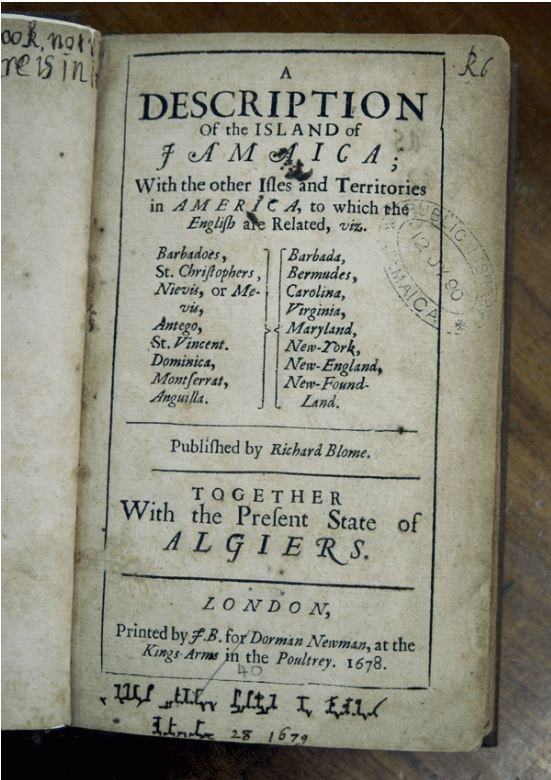Travel in Jamaica: Buccaneers at the National Library in Downtown Kingston, in the Year 2012
- by Thibault Ehrengardt

Richard Blome's Description of Jamaica.
PART II : Buccaneers’ Paradise.
BOOK 1: Richard Blome, A Description of the Island of Jamaica, With the Other Isles and Territories in America, to Which the English are Related (London, 1678).
The National Library of Jamaica (NLJ) shelters some old books linked to the history of the island. Last month, I described the copy of Thomas Gage’s travel that played a key role in the English capturing Jamaica in 1655. The first years of the island under English dominion were rough times. Despite Oliver Cromwell’s privileges granted to the new settlers (including the English nationality), few wanted to migrate to this remote and unknown island, said to be hostile and unhealthy. By 1670, Jamaica became an official possession of the restored Crown and the book A Description of the Island of Jamaica... by Richard Blome was used as a tool of propaganda to help populating the colony. It was, as the NLJ states, published “at the request of Charles II, King of England.” The staff of the library handed me a disappointing in-12 volume, rebound in modern clothe. The inside, though, is very bright and complete of all maps, except... the one of Jamaica which, Lord forgives, has been carefully removed. A note of the library sends the desperate reader to the “map collection” with a barbarous reference (727 Fa 1671). This map was deeply inspired by its historical predecessor of 1671, John Ogilby’s, “the prototype of most of the first maps of Jamaica” says the NLJ. Twenty-seven pages only are dedicated to Jamaica. The rest focuses on “the other Isles and Territories in America, to which the English are Related”. The “Island of Barbadoes” is here described. So are Virginia or New-York. The work is bound with The Present State of Algiers (1678).
The idea was to attract new settlers to the young colony – it’d better be a good book. Blome describes a paradise regained, with fertile soils, a rich and generous nature giving gorgeous fruits. A heavenly haven... Enhanced in such a way, the island could not fail to rapidly prosper. To be honest, it did. Thanks to her natural ressources, indeed – but also thanks to the “ressources” stolen by the buccanners from the Spaniards. In the 1670’s, the island became the turf of the most feared men of their time, the dreadful buccaneers, who almost ruined the Spanish empire in America while turning Port Royal into “the most wicked city on Earth”... and one of the richest.
*** *** ***